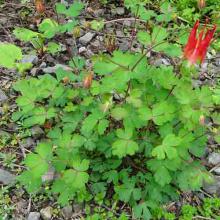Aquilegia canadensis
Common name:
Red columbine
Genus:
Aquilegia
Family:
Ranunculaceae
Order:
Ranunculales
Aquilegia canadensis
Common name:
Red columbine
Genus:
Aquilegia
Family:
Ranunculaceae
Order:
Ranunculales
Aquilegia canadensis
Common name:
Red columbine
Genus:
Aquilegia
Family:
Ranunculaceae
Order:
Ranunculales
Genus (Plantae): Aquilegia
Aquilegia (common names: granny's bonnet, columbine) is a genus of about 60–70 species of perennial plants that are found in meadows, woodlands, and at higher altitudes throughout the Northern Hemisphere, known for the spurred petals of their flowers.
Etymology
The genus name Aquilegia is derived from the Latin word for eagle (aquila), because of the shape of the flower petals, which are said to resemble an eagle's claw. The common name "columbine" comes from the Latin for "dove", due to the resemblance of the inverted flower to five doves clustered together.
Description
Perennial herbs, with woody, erect stock, roots forming thick rhizomes. The basal leaves are compound, 1–3 ternate, blades 3-lobed -partite, and lobes lobulate and obtuse. The cauline leaves are similar to the basal ones, while the upper ones are bract like.
The are hermaphrodite (bisexual) flowers are terminal to stem and branches. They are usually pentamerous (with five spreading perianth petaloid sepal segments). Five tubular honey-leaves are semi erect with a flat limb and spurred or saccate at the base. The spur is directed backwards and secretes nectar. Stamens are numerous (often more than 50) in whorls of 5, the innermost being scarious staminodes. There are ten membranaceous intrastaminal scales. There are five pistils and the Carpels are free.
The fruit has several (five to 15) follicles which are semi erect and slightly connate downwards. These hold many seeds and are formed at the end of the pistils. The nectar is mainly consumed by long-beaked birds such as hummingbirds. Almost all Aquilegia species have a ring of staminodia around the base of the stigma, which may help protect against insects. Chromosome number is x=7.
Insects
They are used as food plants by some Lepidoptera (butterfly and moth) caterpillars. These are mainly of noctuid moths – noted for feeding on many poisonous plants without harm – such as cabbage moth (Mamestra brassicae), dot moth (Melanchra persicariae) and mouse moth (Amphipyra tragopoginis). the engrailed (Ectropis crepuscularia), a geometer moth, also uses columbine as a larval food plant. The larvae of the Papaipema leucostigma also feed on columbine.
Plants in the genus Aquilegia are a major food source for Bombus hortorum, a species of bumblebee. Specifically, they have been found to forage on species of Aquilegia vulgaris in Belgium and Aquilegia chrysantha in North America and Belgium. The bees do not show any preference in color of the flowers.
Reference: Wikipedia

